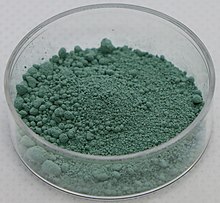Uranium (IV) fluoride
| Crystal structure | ||||||||||||||||
|---|---|---|---|---|---|---|---|---|---|---|---|---|---|---|---|---|

|
||||||||||||||||
| __ U 4+ __ F - | ||||||||||||||||
| Crystal system | ||||||||||||||||
| Space group |
C 2 / c (No. 15) |
|||||||||||||||
| Lattice parameters |
a = 1273 pm |
|||||||||||||||
| General | ||||||||||||||||
| Surname | Uranium (IV) fluoride | |||||||||||||||
| other names |
Uranium tetrafluoride |
|||||||||||||||
| Ratio formula | UF 4 | |||||||||||||||
| Brief description |
green monoclinic crystals |
|||||||||||||||
| External identifiers / databases | ||||||||||||||||
|
||||||||||||||||
| properties | ||||||||||||||||
| Molar mass | 314.02 g mol −1 | |||||||||||||||
| Physical state |
firmly |
|||||||||||||||
| density |
6.7 g cm −3 |
|||||||||||||||
| Melting point |
1036 ° C |
|||||||||||||||
| boiling point |
1417 ° C |
|||||||||||||||
| Hazard and safety information | ||||||||||||||||
 Radioactive |
||||||||||||||||
|
||||||||||||||||
| Thermodynamic properties | ||||||||||||||||
| ΔH f 0 |
- (1920.0 ± 3.7) kJ mol −1 |
|||||||||||||||
| As far as possible and customary, SI units are used. Unless otherwise noted, the data given apply to standard conditions . | ||||||||||||||||
Uranium (IV) fluoride (UF 4 ), usually called uranium tetrafluoride , is a chemical compound made up of the elements uranium and fluorine . It is a green crystalline solid and, due to its ionic bond, a salt. It is therefore known as the “green salt” . UF 4 is usually an intermediate product in the conversion of uranium hexafluoride (UF 6 ) to both the uranium oxides (U 3 O 8 or UO 2 ) and the uranium metal.
presentation
It is formed by the action of HF on uranium dioxide (UO 2 )
or by reaction of UF 6 with hydrogen gas
Very pure uranium (IV) fluoride can be obtained by passing dry dichlorodifluoromethane (Freon 12) over 400 ° C uranium (VI) oxide .
properties
Physical Properties
Uranium (IV) fluoride crystallizes in the monoclinic crystal system in the space group C 2 / c (space group No. 15) with the lattice parameters a = 1273 pm , b = 1075 pm, c = 843 pm, β = 126 ° and twelve formula units per Unit cell .
Chemical properties
UF 4 gradually hydrolyzes to UO 2 and HF on contact with water . Because of this behavior, storage in humid air is not recommended; instead, it should be stored in dry air or under inert gas.
safety instructions
UF 4 is highly toxic when inhaled and swallowed. In addition, there is a risk of uranium accumulation in the human body, which particularly affects the liver and kidneys . It is also toxic to aquatic organisms and can cause long-term damage to the aquatic world. Like all uranium compounds, it is radioactive . The activity depends on the isotopic composition of the uranium.
literature
- Ingmar Grenthe, Janusz Drożdżynński, Takeo Fujino, Edgar C. Buck, Thomas E. Albrecht-Schmitt, Stephen F. Wolf: Uranium , in: Lester R. Morss, Norman M. Edelstein, Jean Fuger (eds.): The Chemistry of the Actinide and Transactinide Elements , Springer, Dordrecht 2006; ISBN 1-4020-3555-1 , pp. 253-698 ( doi: 10.1007 / 1-4020-3598-5_5 ).
- S. Kern, J. Hayward, S. Roberts, JW Richardson, FJ Rotella, L. Soderholm, B. Cort, M. Tinkle, M. West, D. Hoisington, GH Lander: Temperature Variation of the Structural Parameters in Actinide Tetrafluorides , in: Journal of Chemical Physics , 1994 , 101 , pp. 9333-9337 ( doi: 10.1063 / 1.467963 ).
Individual evidence
- ↑ a b c d David R. Lide (Ed.): CRC Handbook of Chemistry and Physics . 90th edition. (Internet version: 2010), CRC Press / Taylor and Francis, Boca Raton, FL, Properties of the Elements and Inorganic Compounds, pp. 4-97.
- ↑ Entry on uranium compounds in the GESTIS substance database of the IFA , accessed on February 1, 2016(JavaScript required) .
- ↑ Not explicitly listed in Regulation (EC) No. 1272/2008 (CLP) , but with the specified labeling it falls under the group entry uranium compounds with the exception of those specified elsewhere in this Annex in the Classification and Labeling Inventory of the European Chemicals Agency (ECHA) , accessed on February 1, 2016. Manufacturers or distributors can expand the harmonized classification and labeling .
- ↑ The hazards emanating from radioactivity do not belong to the properties to be classified according to the GHS labeling.
- ↑ EHP Cordfunke, W. Ouweltjes: Standard Enthalpies of Formation of Uranium Compounds VII. UF 3 and UF 4 (by Solution Calorimetry) , in: The Journal of Chemical Thermodynamics , 1981 , 13 (2), pp. 193-197 ( doi : 10.1016 / S0021-9614 (81) 80025-0 ).
- ↑ HS Booth, W. Krasny-Ergen, RE Heath: Uranium Tetrafluoride , in: Journal of the American Chemical Society , 1946 , 68 (10), pp. 1969-1970 ( doi: 10.1021 / ja01214a028 ).
- ↑ G. Brauer (Ed.), Handbook of Preparative Inorganic Chemistry 2nd ed., Vol. 1, Academic Press 1963, pp. 261-262.
- ^ AC Larson, RB Roof Jnr, DT Cromer: The Crystal Structure of UF 4 , in: Acta Crystallographica , 1964 , 17 , pp. 555-558 ( doi: 10.1107 / S0365110X64001293 ).
- ↑ Uranium Tetrafluoride, Appendix A of the PEIS (DOE / EIS-0269)







